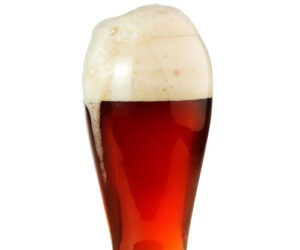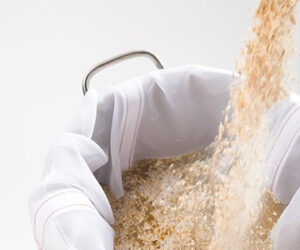Brewing Sour Beers: Tips from the Pros
Brewer: Ted Miller, Brugge Brasserie in Indianapolis, IN
If we start at the beginning, I guess the question to answer is: What’s the best grain bill for a brewer to work with when making sour beers? This depends on whether you are targeting an old bruin or a lambic. I like a touch of crystal malt, Special B and chocolate malts in my bruins. My lambic bill, though, is nothing but a Pilsner malt and wheat.
As for hops, I would recommend that home brewers stay away from any high alpha variety (such as Simcoe, Chinook and the likes) and any hop with extremely identifiable characteristics (like Cascade and Amarillo). I use Tettnanger almost exclusively. Also, using whole, aged hops that are well past the “organic rot” aroma stage can also make a big impact. It takes planning to make one of these sour gems.
A brewer can do one of two things depending on time: Put hops into a breathable container somewhere out of the way for two years, or bake them at very low temperatures (200 ºF or 93 ºC) for several hours (at least 4–6). Personally, I like to let nature run its course. This will give your beer the aged-hop flavor I find preferable in my sour beer.
As for the souring process, the hobbyist needs to acquire the pure cultures. It would be futile to culture from a bottle, and in most cases you would simply be culturing Saccharomyces anyway. The beer in that bottle is so far removed from the source bacteria that it would be nearly impossible to achieve the stage of becoming “ill.” The ill (or sour) stage has been my entire battle with these brews. It is easy to achieve if you’ve got a 400 year-old barrel, teaming with all the required beasts, but to do it in the middle of say, Taiwan or China, where I was for the past several years, or now here in Indiana, it proves more of a challenge.
After a gentle primary (2 months), you will need to inoculate with Pediococcus cerevisiae. This will create a high level of lactic acid. This can take a long while, so consistent monitoring of the fermentation is necessary. It can be extremely disappointing to break out the old barrel thief only to find your lambic isn’t lambic at all — but rather an extremely nasty cesspool of Brettanomyces.
Speaking of Brettanomyces, I inoculate with Brettanomyces lambicus after six months. Brettanomyces lambicus produces the immediately identifiable “horse blanket” characteristic. At what levels to inoculate is a matter of debate. Varying amounts of Brettanomyces create a wide spectrum of flavors, so you will need to develop a taste for it and gauge your brewing accordingly.
Brewer: Peter Bouckaert, New Belgium Brewing Co. in Fort Collins, CO
Once you have collected the required bacteria for sour beers, it is crucial to store them in a secure manner. I boil up a sugar solution — 10–14% sugar with some egg white and beer (for bitterness) to maintain and propagate the critters in this liquid. At pitch, add this slurry and a sufficient amount of regular yeast. Once you have a good solution of bacteria for your sour beer, limiting acid is key. Do this by increasing alcohol, depleting nutrients and reducing pH.
A sufficient amount of bacteria-free yeast and temperature control, though, are our main weapons. In most cases, I start with a well fermentable, lowly hopped wort (15–20 IBU). Let the fermentation rise to room temperature or higher if possible — as high as 95 ºF (35 ºC) — to speed up the depletion of sugars. When fermentation is close to completion, cool as fast as you can to capture the desired lactic sour flavor.
Brewer: Tomme Arthur, Port Brewing in California (Solana Beach, San Clemente and Carlsbad).
When it comes to making Belgian-style sour beers, we employ several different kinds of malts with each malt providing certain foundations. In our Cuveé de Tommé, a Belgian-style dark strong ale, we are looking to support the bourbon barrel character and the strong charred oak flavors by adding a nice caramel malt base. In our Le Woody Blonde Belgian Style Ale, we attempted to brew a beer with a lighter body and therefore chose no crystal malt, opting to use Vienna malt and flaked corn instead.
Hops play an important role in sour beers. There are many compounds that are found in new hops that are not desirable in sour beers. When the hops are aged, those compounds fall to reduced levels. The role of hops in sour ale beers is to provide not bitterness but other acids in a supporting role.
We use a process of adding pure isolated cultures to our brews at specific intervals. It is in this way that we can control and best manipulate the finished beer. Numerous isolated cultures are available to the homebrewer through Wyeast and White Labs. Other homebrewers and some professional brewers are using dregs of yeast cultured from lambic beers. These cultures contain Pediococcus, Lacto-bacillous and Brettanomyces. The only drawback to using these types of mixed cultures is the inability to separate each type of fermentation.
All of our soured beers start with conventional primary fermentation before proceeding to a barrel where the real magic takes place. We ensure through the primary fermentation that we have hit our target levels of alcohol, bitterness and attenuation before proceeding to the barrel.
For a homebrewer, no extra special equipment is needed. While oak is desired for its oxygen transporting abilities — and widely used in commercial brewing — plastic is an acceptable substitute as it has a permeable membrane allowing oxygen transport as well. If plastic buckets are used, oak chips can be added as a flavoring compound that also provides some tannins.
We add our souring culture (mostly Pediococcus and Brettanomyces) after a one-month primary fermentation. The goal of this fermentation is to attenuate the beer to the proper level and then settle out as much of the yeast from the primary as possible. This separation of old yeast ensures that we do not develop yeast autolysis, which can produce a burnt rubber smell in the beer.


